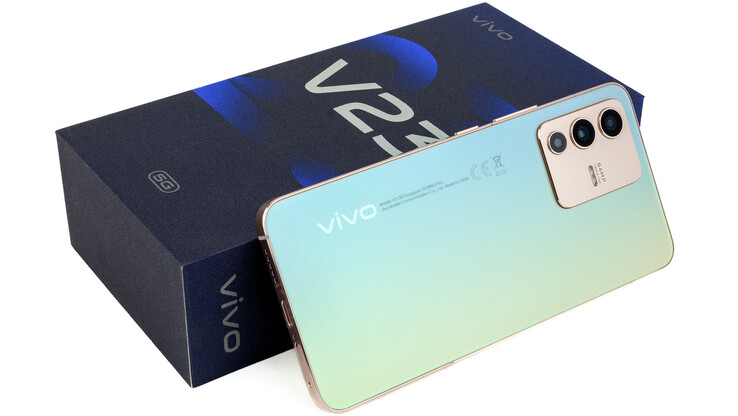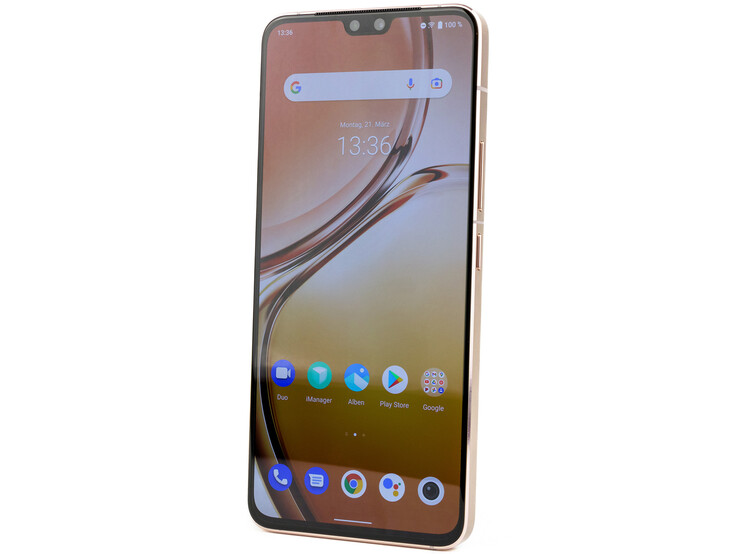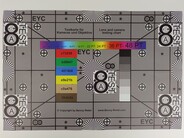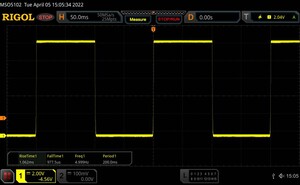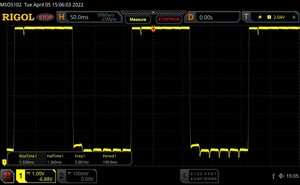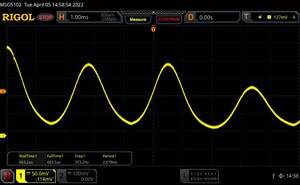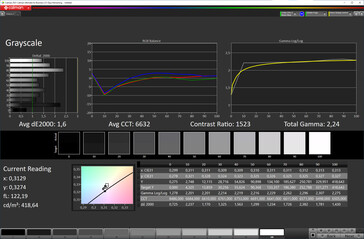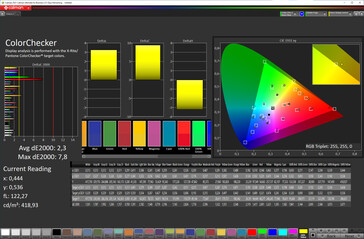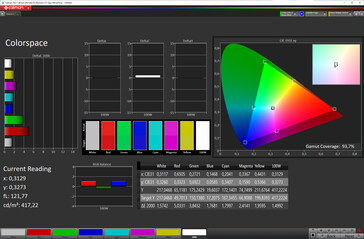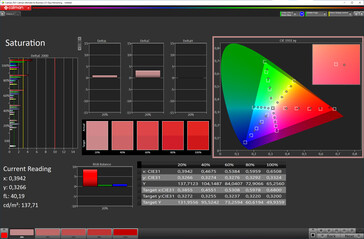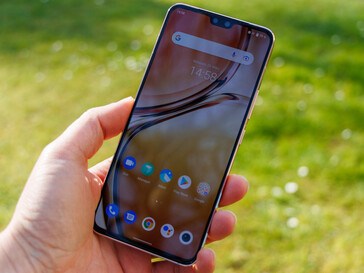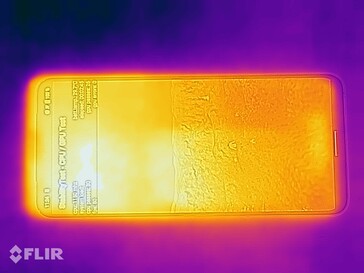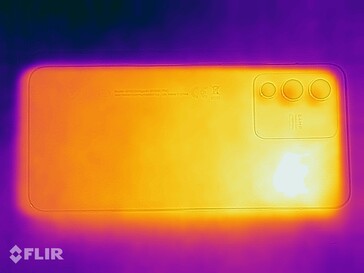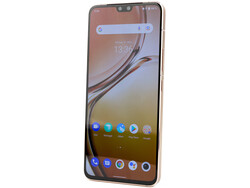Vivo V23 5G review - Selfie smartphone with extravagant color
Possible competitors in comparison
Rating | Date | Model | Weight | Drive | Size | Resolution | Price |
|---|---|---|---|---|---|---|---|
| 83.6 % v7 (old) | 06 / 2022 | Vivo V23 5G Dimensity 920, Mali-G68 MP4 | 181 g | 256 GB UFS 2.2 Flash | 6.44" | 2400x1080 | |
| 87.4 % v7 (old) | 11 / 2021 | Google Pixel 6 Tensor, Mali-G78 MP20 | 207 g | 128 GB UFS 3.1 Flash | 6.40" | 2400x1080 | |
| 88.8 % v7 (old) | 02 / 2022 | Samsung Galaxy S21 FE 5G SD 888 5G, Adreno 660 | 177 g | 128 GB UFS 3.1 Flash | 6.40" | 2340x1080 | |
| 88.1 % v7 (old) | 03 / 2022 | Xiaomi 12X SD 870, Adreno 650 | 176 g | 256 GB UFS 3.1 Flash | 6.28" | 2400x1080 |
Case and features - Vivo V23 5G with chic color gradient
The Vivo V23 5G is available in Sunshine Gold and Stardust Black. The former is also our test device, whose back can change color in a UV light. The slightly glittering gold then turns into a rich turquoise. It is also protected by Schott Xensation Up glass on both sides.
The build quality is good and the matte glass on the back is not susceptible to fingerprints. However, this does not apply to the highly polished aluminum frame, which features an angular design
The equipment list is quite short. The USB port only works according to the 2.0 standard and there is neither a microSD slot nor an audio jack. Wireless charging is also not supported.
Communication, software and operation - Vivo V23 with 5G and Wi-Fi 6
The Vivo V23 uses a Wi-Fi 6 module that enables high and stable data transmissions in combination with our reference router Asus ROG Rapture GT-AXE11000. The cellular modem covers all modern standards and offers a wide spectrum of frequency bands.
The Vivo smartphone also delivers good voice quality in both directions. VoLTE and Wi-Fi calls are supported. Vivo has also directly implemented SIP account management into the system.
Google's Android 12 is used as the operating system, over which the manufacturer sprinkles its own user interface, Funtouch OS 12. It looks less modern than the newer Origin OS, which is used in China. The security patches were up to date on May 1, 2022, at the time of the testing.
The capacitive touchscreen responds quickly and reliably to inputs and the screen is also covered with a protective film at the factory. The Schott glass underneath is much more slippery and haptically very pleasant. Biometric security is provided by an optical fingerprint scanner underneath the display, which works very reliably but is comparatively slow when the smartphone is unlocked from standby. The process is noticeably faster when the display is active.
| Networking | |
| Vivo V23 5G | |
| iperf3 transmit AXE11000 | |
| iperf3 receive AXE11000 | |
| Google Pixel 6 | |
| iperf3 transmit AX12 | |
| iperf3 receive AX12 | |
| Samsung Galaxy S21 FE 5G | |
| iperf3 transmit AXE11000 | |
| iperf3 receive AXE11000 | |
| Xiaomi 12X | |
| iperf3 transmit AXE11000 | |
| iperf3 receive AXE11000 | |
Cameras - Dual optics on the front with flash
The stars of the Vivo V23 5G are on the front. The 50 MP main sensor not only has an autofocus, but also an additional ultra-wide-angle lens. Two LED spots are also supposed to ensure perfect illumination at all times. This allows for really good selfies in everyday use, which are also successful in backlight with an automatic HDR mode. Vivo also provides numerous filters and effects. Unfortunately, videos can only be recorded in Ultra HD with 30 FPS or in Full HD with 60 FPS. More is not possible with the SoC.
The main camera on the back turns out to be better than average. The color reproduction is not always natural because the display is too bright. Nevertheless, pictures lack brilliance and the dynamic range should be larger. The ultra-wide-angle shows a shallow depth of field and the macro lens only has a resolution of 2 MP.
Image comparison
Choose a scene and navigate within the first image. One click changes the position on touchscreens. One click on the zoomed-in image opens the original in a new window. The first image shows the scaled photograph of the test device.
HauptkameraHauptkameraUltraweitwinkel5-facher ZoomLow-Light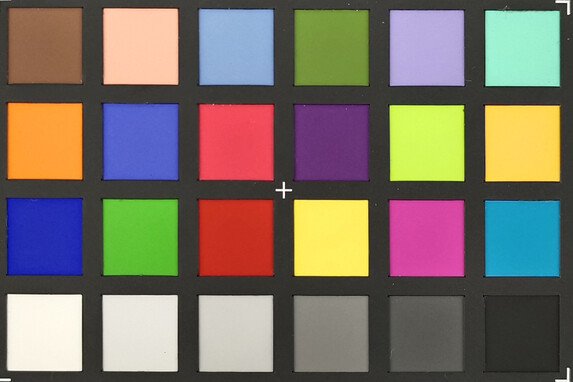

Display - Vivo smartphone with 90 Hz OLED
The 6.44-inch AMOLED display of the Vivo V23 5G has a refresh rate of up to 90 Hz. It can either be set to 60 or 90 Hz or switch between the two modes automatically.
The brightness values are good with an enabled ambient light sensor, but those who prefer to adjust the brightness manually will only have 299 cd/m² available. With an even distribution of bright and dark areas (APL18), the luminosity increases up to 792 cd/m². That is quite bright, but there are competitors in this price range that have much more reserves.
Like other smartphones with OLED panels, the Vivo V23 uses PWM to regulate brightness. The frequency ranges between 119 and 373.2 Hz in minimum brightness. Above 54% of the adjustable brightness, only 60 or 90 Hz are measurable depending on the set refresh rate.
| |||||||||||||||||||||||||
Brightness Distribution: 98 %
Center on Battery: 606 cd/m²
Contrast: ∞:1 (Black: 0 cd/m²)
ΔE ColorChecker Calman: 2.3 | ∀{0.5-29.43 Ø4.78}
ΔE Greyscale Calman: 1.6 | ∀{0.09-98 Ø5}
93.7% sRGB (Calman 2D)
Gamma: 2.24
CCT: 6632 K
| Vivo V23 5G AMOLED, 2400x1080, 6.4" | Google Pixel 6 OLED, 2400x1080, 6.4" | Samsung Galaxy S21 FE 5G Dynamic AMOLED 2X, 2340x1080, 6.4" | Xiaomi 12X OLED, 2400x1080, 6.3" | |
|---|---|---|---|---|
| Response Times | -105% | -153% | 56% | |
| Response Time Grey 50% / Grey 80% * (ms) | 2.688 ? | 6.8 ? -153% | 10.4 ? -287% | 0.777 ? 71% |
| Response Time Black / White * (ms) | 2.04 ? | 3.2 ? -57% | 2.4 ? -18% | 1.204 ? 41% |
| PWM Frequency (Hz) | 373.2 | 367.6 ? | 247.5 | 523 |
| Screen | 24% | 17% | 43% | |
| Brightness middle (cd/m²) | 606 | 805 33% | 758 25% | 910 50% |
| Brightness (cd/m²) | 606 | 805 33% | 758 25% | 908 50% |
| Brightness Distribution (%) | 98 | 98 0% | 99 1% | 97 -1% |
| Black Level * (cd/m²) | ||||
| Colorchecker dE 2000 * | 2.3 | 1.4 39% | 1.5 35% | 0.8 65% |
| Colorchecker dE 2000 max. * | 7.8 | 3.7 53% | 3.1 60% | 1.8 77% |
| Greyscale dE 2000 * | 1.6 | 1.8 -13% | 2.3 -44% | 1.3 19% |
| Gamma | 2.24 98% | 2.29 96% | 2.06 107% | 2.25 98% |
| CCT | 6632 98% | 6507 100% | 6378 102% | 6414 101% |
| Total Average (Program / Settings) | -41% /
-8% | -68% /
-25% | 50% /
47% |
* ... smaller is better
Display Response Times
| ↔ Response Time Black to White | ||
|---|---|---|
| 2.04 ms ... rise ↗ and fall ↘ combined | ↗ 1.062 ms rise | |
| ↘ 0.9775 ms fall | ||
| The screen shows very fast response rates in our tests and should be very well suited for fast-paced gaming. In comparison, all tested devices range from 0.1 (minimum) to 240 (maximum) ms. » 10 % of all devices are better. This means that the measured response time is better than the average of all tested devices (20.2 ms). | ||
| ↔ Response Time 50% Grey to 80% Grey | ||
| 2.688 ms ... rise ↗ and fall ↘ combined | ↗ 1.328 ms rise | |
| ↘ 1.36 ms fall | ||
| The screen shows very fast response rates in our tests and should be very well suited for fast-paced gaming. In comparison, all tested devices range from 0.165 (minimum) to 636 (maximum) ms. » 11 % of all devices are better. This means that the measured response time is better than the average of all tested devices (31.6 ms). | ||
Screen Flickering / PWM (Pulse-Width Modulation)
| Screen flickering / PWM detected | 373.2 Hz | ||
The display backlight flickers at 373.2 Hz (worst case, e.g., utilizing PWM) . The frequency of 373.2 Hz is relatively high, so most users sensitive to PWM should not notice any flickering. However, there are reports that some users are still sensitive to PWM at 500 Hz and above, so be aware. In comparison: 53 % of all tested devices do not use PWM to dim the display. If PWM was detected, an average of 8111 (minimum: 5 - maximum: 343500) Hz was measured. | |||
Measurement series with fixed zoom level and different brightness settings
Performance, emissions and battery life
The Vivo V23 5G is powered by a MediaTek Dimensity 920 which, however, hardly differs from its predecessor Dimensity 900 differs. On paper, only the clock of the two Cortex-A78 performance cores has been increased by 100 MHz each. MediaTek promises a nine percent higher gaming performance, but Vivo is not able to tease this out. The test with GameBench even shows only 30 FPS in Armajet. However, the smartphone's temperature development is inconspicuous, both for the surfaces and the SoC.
The speaker on the chin can get very loud, but only offers a mediocre quality that is characterized by a hollow appearance. However, the sound is quite alright when the Vivo smartphone is not set too loud. The V23 does not have a jack, but the sound can be output via USB-C. Bluetooth is available wirelessly and supports all common audio codecs (SBC, AAC, aptX, aptX HD, aptX Adaptive, aptX TWS+, and LDAC)
The 4,200 mAh strong battery supplies the phone with energy for almost 15 hours in the WLAN test with adjusted display brightness (150 cd/m²), although the panel works constantly with 90 Hz. Thus, the V23 is well equipped for long days.
| AImark - Score v2.x (sort by value) | |
| Vivo V23 5G | |
| Google Pixel 6 | |
| Samsung Galaxy S21 FE 5G | |
| Xiaomi 12X | |
| Oppo Find X5 Lite | |
| Average MediaTek Dimensity 920 (n=1) | |
| UL Procyon AI Inference for Android - Overall Score NNAPI (sort by value) | |
| Vivo V23 5G | |
| Google Pixel 6 | |
| Average MediaTek Dimensity 920 (21981 - 23618, n=2) | |
| Average of class Smartphone (3769 - 81594, n=139, last 2 years) | |
GFXBench (DX / GLBenchmark) 2.7: T-Rex Onscreen | 1920x1080 T-Rex Offscreen
GFXBench 3.0: on screen Manhattan Onscreen OGL | 1920x1080 1080p Manhattan Offscreen
GFXBench 3.1: on screen Manhattan ES 3.1 Onscreen | 1920x1080 Manhattan ES 3.1 Offscreen
GFXBench: on screen Car Chase Onscreen | 1920x1080 Car Chase Offscreen | on screen Aztec Ruins High Tier Onscreen | 2560x1440 Aztec Ruins High Tier Offscreen | on screen Aztec Ruins Normal Tier Onscreen | 1920x1080 Aztec Ruins Normal Tier Offscreen
| 3DMark / Wild Life Extreme Unlimited | |
| Nubia RedMagic 7 | |
| Xiaomi 12 | |
| Motorola Edge 30 Pro | |
| Asus ROG Phone 5s | |
| Vivo V23 5G | |
| Oppo Find X5 Lite | |
| 3DMark / Wild Life Extreme | |
| Nubia RedMagic 7 | |
| Xiaomi 12 | |
| Motorola Edge 30 Pro | |
| Asus ROG Phone 5s | |
| Vivo V23 5G | |
| Oppo Find X5 Lite | |
| 3DMark / Wild Life Unlimited Score | |
| Nubia RedMagic 7 | |
| Xiaomi 12 | |
| Motorola Edge 30 Pro | |
| Asus ROG Phone 5s | |
| Vivo V23 5G | |
| Oppo Find X5 Lite | |
| 3DMark / Wild Life Score | |
| Nubia RedMagic 7 | |
| Xiaomi 12 | |
| Motorola Edge 30 Pro | |
| Asus ROG Phone 5s | |
| Vivo V23 5G | |
| Oppo Find X5 Lite | |
| 3DMark / Sling Shot Extreme (Vulkan) Unlimited Physics | |
| Vivo V23 5G | |
| Oppo Find X5 Lite | |
| Xiaomi 12 | |
| 3DMark / Sling Shot Extreme (Vulkan) Unlimited Graphics | |
| Vivo V23 5G | |
| Oppo Find X5 Lite | |
| Xiaomi 12 | |
| 3DMark / Sling Shot Extreme (Vulkan) Unlimited | |
| Vivo V23 5G | |
| Oppo Find X5 Lite | |
| Xiaomi 12 | |
| 3DMark / Sling Shot Extreme (ES 3.1) Unlimited Physics | |
| Asus ROG Phone 5s | |
| Nubia RedMagic 7 | |
| Xiaomi 12 | |
| Vivo V23 5G | |
| Oppo Find X5 Lite | |
| 3DMark / Sling Shot Extreme (ES 3.1) Unlimited Graphics | |
| Nubia RedMagic 7 | |
| Xiaomi 12 | |
| Asus ROG Phone 5s | |
| Vivo V23 5G | |
| Oppo Find X5 Lite | |
| 3DMark / Sling Shot Extreme (ES 3.1) Unlimited | |
| Nubia RedMagic 7 | |
| Xiaomi 12 | |
| Asus ROG Phone 5s | |
| Vivo V23 5G | |
| Oppo Find X5 Lite | |
| GFXBench (DX / GLBenchmark) 2.7 / T-Rex Onscreen | |
| Xiaomi 12 | |
| Motorola Edge 30 Pro | |
| Vivo V23 5G | |
| Oppo Find X5 Lite | |
| GFXBench (DX / GLBenchmark) 2.7 / T-Rex Offscreen | |
| Xiaomi 12 | |
| Motorola Edge 30 Pro | |
| Vivo V23 5G | |
| Oppo Find X5 Lite | |
| GFXBench 3.0 / Manhattan Onscreen OGL | |
| Xiaomi 12 | |
| Motorola Edge 30 Pro | |
| Vivo V23 5G | |
| Oppo Find X5 Lite | |
| GFXBench 3.0 / 1080p Manhattan Offscreen | |
| Xiaomi 12 | |
| Motorola Edge 30 Pro | |
| Vivo V23 5G | |
| Oppo Find X5 Lite | |
| GFXBench 3.1 / Manhattan ES 3.1 Onscreen | |
| Xiaomi 12 | |
| Motorola Edge 30 Pro | |
| Vivo V23 5G | |
| Oppo Find X5 Lite | |
| GFXBench 3.1 / Manhattan ES 3.1 Offscreen | |
| Xiaomi 12 | |
| Motorola Edge 30 Pro | |
| Vivo V23 5G | |
| Oppo Find X5 Lite | |
| GFXBench / Car Chase Onscreen | |
| Xiaomi 12 | |
| Motorola Edge 30 Pro | |
| Vivo V23 5G | |
| Oppo Find X5 Lite | |
| GFXBench / Car Chase Offscreen | |
| Motorola Edge 30 Pro | |
| Xiaomi 12 | |
| Vivo V23 5G | |
| Oppo Find X5 Lite | |
| GFXBench / Aztec Ruins High Tier Onscreen | |
| Xiaomi 12 | |
| Motorola Edge 30 Pro | |
| Nubia RedMagic 7 | |
| Asus ROG Phone 5s | |
| Vivo V23 5G | |
| Oppo Find X5 Lite | |
| GFXBench / Aztec Ruins High Tier Offscreen | |
| Nubia RedMagic 7 | |
| Motorola Edge 30 Pro | |
| Xiaomi 12 | |
| Asus ROG Phone 5s | |
| Vivo V23 5G | |
| Oppo Find X5 Lite | |
| GFXBench / Aztec Ruins Normal Tier Onscreen | |
| Motorola Edge 30 Pro | |
| Xiaomi 12 | |
| Nubia RedMagic 7 | |
| Asus ROG Phone 5s | |
| Vivo V23 5G | |
| Oppo Find X5 Lite | |
| GFXBench / Aztec Ruins Normal Tier Offscreen | |
| Nubia RedMagic 7 | |
| Motorola Edge 30 Pro | |
| Xiaomi 12 | |
| Asus ROG Phone 5s | |
| Vivo V23 5G | |
| Oppo Find X5 Lite | |
| Vivo V23 5G | Google Pixel 6 | Samsung Galaxy S21 FE 5G | Xiaomi 12X | Average 256 GB UFS 2.2 Flash | Average of class Smartphone | |
|---|---|---|---|---|---|---|
| AndroBench 3-5 | -13% | 32% | 49% | 14% | 121% | |
| Sequential Read 256KB (MB/s) | 994.44 | 1546 55% | 1639 65% | 1732 74% | 903 ? -9% | 2223 ? 124% |
| Sequential Write 256KB (MB/s) | 497.9 | 233.4 -53% | 760 53% | 795 60% | 727 ? 46% | 1838 ? 269% |
| Random Read 4KB (MB/s) | 219.19 | 126.2 -42% | 245.1 12% | 291.9 33% | 226 ? 3% | 295 ? 35% |
| Random Write 4KB (MB/s) | 214.81 | 190.3 -11% | 211.2 -2% | 279.9 30% | 247 ? 15% | 335 ? 56% |
Games
Temperature
(+) The maximum temperature on the upper side is 30.8 °C / 87 F, compared to the average of 35.2 °C / 95 F, ranging from 21.9 to 247 °C for the class Smartphone.
(+) The bottom heats up to a maximum of 30.4 °C / 87 F, compared to the average of 34 °C / 93 F
(+) In idle usage, the average temperature for the upper side is 26.3 °C / 79 F, compared to the device average of 32.9 °C / 91 F.
Speaker
Vivo V23 5G audio analysis
(+) | speakers can play relatively loud (91.6 dB)
Bass 100 - 315 Hz
(-) | nearly no bass - on average 24.1% lower than median
(+) | bass is linear (6.4% delta to prev. frequency)
Mids 400 - 2000 Hz
(±) | reduced mids - on average 5% lower than median
(+) | mids are linear (4.5% delta to prev. frequency)
Highs 2 - 16 kHz
(±) | higher highs - on average 7% higher than median
(+) | highs are linear (3.9% delta to prev. frequency)
Overall 100 - 16.000 Hz
(±) | linearity of overall sound is average (18.8% difference to median)
Compared to same class
» 22% of all tested devices in this class were better, 10% similar, 68% worse
» The best had a delta of 11%, average was 35%, worst was 134%
Compared to all devices tested
» 42% of all tested devices were better, 8% similar, 50% worse
» The best had a delta of 4%, average was 24%, worst was 134%
Xiaomi 12X audio analysis
(+) | speakers can play relatively loud (90.1 dB)
Bass 100 - 315 Hz
(-) | nearly no bass - on average 23% lower than median
(±) | linearity of bass is average (8.2% delta to prev. frequency)
Mids 400 - 2000 Hz
(+) | balanced mids - only 4.1% away from median
(+) | mids are linear (4% delta to prev. frequency)
Highs 2 - 16 kHz
(+) | balanced highs - only 4.5% away from median
(+) | highs are linear (4.8% delta to prev. frequency)
Overall 100 - 16.000 Hz
(±) | linearity of overall sound is average (16.1% difference to median)
Compared to same class
» 5% of all tested devices in this class were better, 4% similar, 90% worse
» The best had a delta of 11%, average was 35%, worst was 134%
Compared to all devices tested
» 25% of all tested devices were better, 5% similar, 70% worse
» The best had a delta of 4%, average was 24%, worst was 134%
Battery life
| Vivo V23 5G 4200 mAh | Google Pixel 6 4614 mAh | Samsung Galaxy S21 FE 5G 4500 mAh | Xiaomi 12X 4500 mAh | Average of class Smartphone | |
|---|---|---|---|---|---|
| Battery Runtime | |||||
| WiFi Websurfing (h) | 14.8 | 10.5 -29% | 9.9 -33% | 17.1 16% | 19.2 ? 30% |
Pros
Cons
Verdict - Extravagant design and good battery runtimes
The Vivo V23 5G convinces with its extraordinary looks, especially in the golden color variant. Those who prefer a more dignified look can opt for the black model. Vivo focuses on selfies and provides the smartphone with a powerful solution that convinces in the test. The two front LEDs can be used with different color temperatures not only for brightening but also for image composition.
With a strong front-facing camera and long battery runtimes, the Vivo V23 5G courts the consumers' favor
The display is also good and shows an accurate color reproduction as well as a high brightness. However, the latter is sometimes higher even in cheaper devices, which can have a positive effect, especially when used outdoors. The installed MediaTek SoC delivers good system performance, even though stutters were visible from time to time in the test.
However, we would have expected at least one more premium feature given the high price. Be it wireless charging or an IP certification. The main camera could also have been equipped with better additional lenses.
For selfies, there will not be a smartphone in this price range that is as good as the Vivo V23 5G. More computing power and a stronger camera are among the features of the Pixel 6 or Xiaomi 12X.
Price and availability
Vivo V23 5G
- 08/30/2022 v7 (old)
Daniel Schmidt




